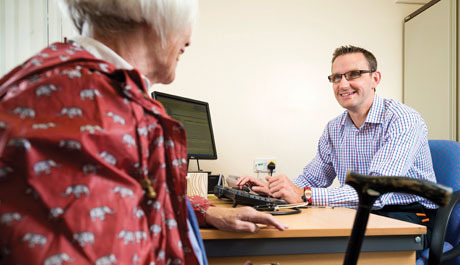Assessing frailty must be a priority for GPs when creating individualised care plans for older patients with type 2 diabetes, new guidelines have warned.
In guidance that is to be adopted across Devon immediately, experts have highlighted the importance of assessing frailty, identifying treatment priorities and establishing clear treatment goals for patients aged over 60 with type 2 diabetes.
The recommendations, published last month in a review article in Diabetic Medicine, were developed by diabetes, geriatric and primary care experts, led by the University of Exeter Medical School, and in partnership with NHS England.
They set out priorities for managing type 2 diabetes in this patient group, with a particular emphasis on identifying frailty.
The authors recommend that patients with diabetes receive a frailty assessment from their GP, including a four metre gait speed test and a ‘get up and go’ test, before an initial management plan is drawn up.
They also recommend that the degree of frailty in older patients is used to inform their treatment with glucose-lowering treatments, stressing the need for every patient to have an individualised care plan.
The authors describe the glycaemic control targets recommended by organisations such as NICE and the American Diabetes Association as ‘too tight’ for elderly patients and suggest that many patients would benefit from ‘de-prescribing’ — having some of their medications withdrawn in order to enhance their clinical outcomes and improve their safety.
They recommend that:
- In fit older adults, the HbA1c treatment target should be 7.5% and the threshold for withdrawing medications that affect quality of life should be 7.0%
- In moderate to severely frail older adults, the HbA1c treatment target should be 8.0% and the threshold for withdrawing medications that affect quality of life should be 7.5%
- In severely frail older adults, the HbA1c treatment target should be 8.5% and the threshold for withdrawing medications that affect quality of life should be 8.0%
The authors said in the review: ‘The focus for diabetes healthcare professionals, in collaboration with older adults with diabetes, should be on preventing diabetes‐disabling states in older people which lead to dependency and institutionalisation and rising health and social care costs.
‘Our proposal to promote the introduction of a frailty assessment scheme as part of routine diabetes management should allow more appropriate and safer treatment strategies to be employed for this continuing relatively neglected older population.’
BMA GP Committee clinical and prescribing policy lead Dr Andrew Green, also one of the study authors, said that working on the paper had been ‘a privilege’ and that he hoped to see patient safety improve as a result of the guidance.
He commented: ‘It has become increasingly recognised that targets for younger people are not appropriate in this group, who are easily harmed by hypoglycaemia that may go unrecognised. The key message is that, as patients become frail, their treatment should be relaxed to deliberately allow their glucose levels to rise to levels above those traditionally regarded as ideal.
‘I hope that GPs reading this work will be encouraged to work with their frail patients to individualise their treatment, taking into account their comorbidities, frailty, and personal wishes, and as a result the harms that can be done by an inappropriate treat-to-target approach can be eliminated.’
Diabet Med 2018; available online 7th April

















